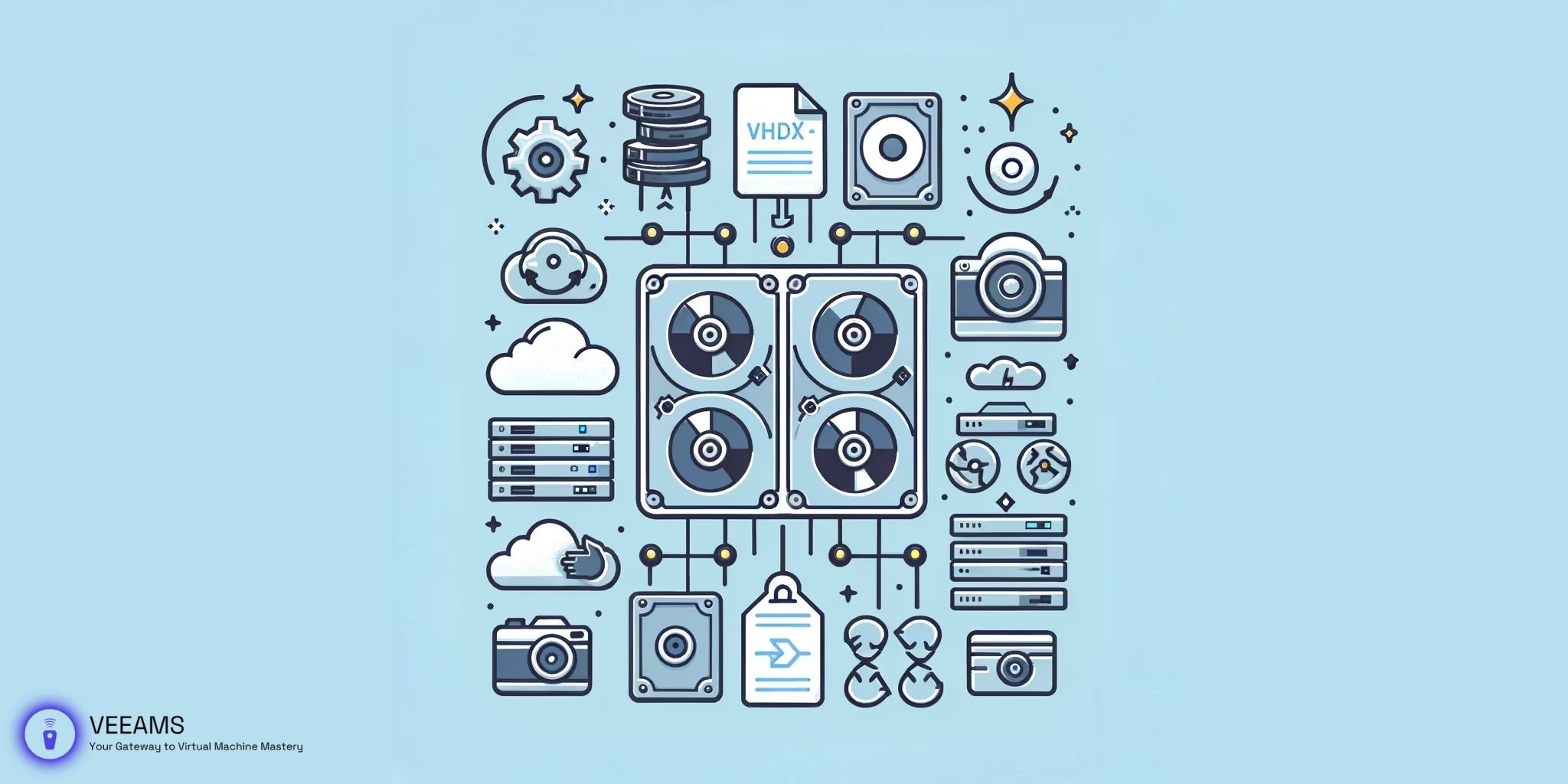Welcome to our guide focused on snapshots and cloning with VHDX files in Hyper-V. Here, we’re going straight into how to make the most of these features, essential for anyone managing virtual environments. This article is crafted for those with a grasp on VHDX basics, ready to delve into more advanced practices.
We’ll guide you through detailed steps on creating snapshots and clones, aiming to equip you with the knowledge to implement these tasks effectively. Whether you’re looking to safeguard your VMs with snapshots or clone VMs for testing, you’ll find clear instructions to follow.
Let’s get started with snapshots in Hyper-V, laying out everything you need to know to use them effectively.
Understanding Snapshots in Hyper-V
Snapshots, also known as checkpoints in newer versions of Hyper-V, are a snapshot in time of a virtual machine’s state and data. They’re invaluable for backup purposes, testing updates, and ensuring that you can quickly revert to a previous state if something goes wrong. Here’s how to effectively use snapshots with your VHDX files.
Creating a Snapshot
- Open Hyper-V Manager: Start by opening the Hyper-V Manager on your Windows system. You can find it by searching for it in the Start menu.
- Select Your VM: In the Hyper-V Manager, look on the left-hand side to find the virtual machine you want to create a snapshot of. Click on the VM to select it.
- Take Snapshot: Right-click on the selected virtual machine, and from the context menu, choose
Checkpoint(orSnapshotin older versions). Alternatively, you can select the VM and find theCheckpointoption in the Actions pane on the right. - Naming and Organizing: After creating the snapshot, it’s a good practice to rename it for easy identification. You can do this by selecting the snapshot in the Snapshots section, right-clicking it, and choosing
Rename. Give it a meaningful name that reflects its purpose or the state of the VM at that point. - Managing Snapshots: You can view and manage all snapshots of a VM in the Hyper-V Manager by selecting the VM and looking at the
Checkpointssection. Here, you can apply, delete, or inspect snapshots.
Tips for Using Snapshots
- Performance Considerations: While snapshots are extremely useful, they can affect VM performance and use significant disk space. Regularly review and consolidate snapshots to maintain system efficiency.
- Not a Backup Solution: Remember, snapshots are not a substitute for a full backup solution. They’re best used for short-term changes or testing environments.
- Automating Snapshot Management: For environments with frequent snapshot needs, consider automating snapshot creation and deletion through PowerShell scripts to save time and reduce manual errors.
Deleting a Snapshot
To delete a snapshot, simply select it in the Hyper-V Manager, right-click, and choose Delete Checkpoint. This will merge the snapshot data back into the main VHDX file, so ensure you no longer need the snapshot before deleting it.
The Basics of Cloning VHDX Files
Cloning is the process of creating an exact copy of a virtual machine, including its state, configurations, and all the data contained within its VHDX files. Unlike snapshots, which capture a moment in time for a single VM, cloning creates a separate and independent VM that can be used just like the original.
Preparing to Clone a VHDX File
Before you clone a VHDX file, ensure that:
- The Source VM is in a Good State: It’s wise to check the VM for any issues and ensure it’s fully updated. This reduces the chance of replicating problems.
- Sysprep the VM (Optional): For Windows-based VMs, consider using Sysprep to generalize the system. This removes system-specific data such as the SID, making the clone more versatile. However, this step is optional and depends on your use case.
- Shut Down the Source VM: Ensure the VM is shut down properly before cloning. This ensures data consistency in the cloned VHDX.
Cloning the VHDX File
- Locate the VHDX File: In Hyper-V Manager, right-click the VM you wish to clone, select
Settings, and note the path of the VHDX file under the Hard Drive section. - Copy the VHDX File: Navigate to the VHDX file location in File Explorer and copy the VHDX file. Paste it into your desired location for the clone.
- Create a New VM: In Hyper-V Manager, select
Action>New>Virtual Machine. Follow the New Virtual Machine Wizard steps, and when prompted for a hard drive, chooseUse an existing virtual hard diskand select the copied VHDX file. - Configure the New VM: After the wizard completes, you may want to adjust the new VM’s settings, such as allocating more RAM or configuring network settings, to suit its intended use.
- Start the New VM: Once configured, start the cloned VM. If you’ve used Sysprep, you’ll go through the out-of-box experience to configure the new VM.
Best Practices for Cloning
- Rename the Cloned VM: Give the cloned VM a meaningful name to avoid confusion with the original VM.
- Check IP Configurations: If the original VM was assigned a static IP address, ensure the cloned VM has a different IP to avoid network conflicts.
- Update the Cloned VM: Especially if the original VM’s snapshot was taken some time ago, check for and apply any necessary updates to the cloned VM.
- Use for Appropriate Scenarios: Cloning is particularly useful for creating development, testing, or backup environments. It’s also handy for scaling out services by deploying multiple instances of a configured VM.

Best Practices for Managing Snapshots and Clones
Effective management of snapshots and clones is key to leveraging their benefits while minimizing potential downsides, such as performance degradation or excessive storage use. Here are some essential tips:
For Snapshots:
- Regularly Review and Consolidate: Snapshots can quickly consume a significant amount of storage space, especially with active VMs. Regularly review existing snapshots and consolidate (merge) or delete those no longer needed.
- Limit Snapshot Depth: Avoid creating a deep hierarchy of snapshots. Each layer adds complexity and can degrade performance. As a general rule, try to limit to just a few snapshots deep.
- Use Snapshots for Short-term Purposes: Snapshots are best used as short-term safety nets during updates or changes, not as long-term backup solutions. For backups, consider using dedicated backup software that’s designed for that purpose.
- Monitor Performance: Be aware of the potential performance impact of snapshots on VMs. Monitoring tools can help identify when snapshots might be affecting system performance and prompt timely consolidation.
For Clones:
- Plan Storage Accordingly: Cloning VMs can quickly double your storage requirements. Plan your storage infrastructure with cloning in mind, considering space for both the original and cloned VHDX files.
- Sysprep for Windows VMs: If you’re cloning Windows VMs, use Sysprep to generalize the OS before cloning. This ensures that each clone is a unique instance, avoiding conflicts like duplicate SIDs.
- Manage IP Addresses Carefully: To prevent network conflicts, ensure each cloned VM has a unique IP address if operating within the same network. This is especially important if the original VM had a static IP configuration.
- Regularly Update Clones: Keep cloned VMs updated, especially if they’re used for testing or development. This ensures that any findings or tests are relevant to the current state of your environment.
- Document Cloning Activities: Keep a record of when clones are created, their purpose, and their intended lifespan. This documentation helps manage clones throughout their lifecycle and ensures they’re deleted when no longer needed, conserving resources.
General Tips:
- Automation: Consider automating snapshot and clone management with PowerShell scripts. Automation can help enforce best practices, such as regular snapshot consolidation and the timely deletion of old clones.
- Capacity Planning: Regularly assess your storage and compute capacity to ensure it meets your needs for snapshots and clones. Effective capacity planning helps avoid resource bottlenecks and ensures efficient system operation.
- Security Considerations: Apply the same security policies and practices to clones and snapshots as you would to your primary VMs. This includes patch management.
Conclusion
In this guide, we’ve covered the essentials of using snapshots and cloning with VHDX files in Hyper-V. These tools are invaluable for managing your virtual environment, offering ways to protect and replicate your VMs efficiently. Remember:
- Snapshots are great for short-term backups and testing changes.
- Cloning allows you to duplicate VMs for various purposes, like development or scaling.
- Always follow best practices to avoid common issues like disk space usage or performance impacts.
By applying the steps and tips shared, you’ll enhance your Hyper-V management skills, ensuring your virtual machines are both secure and efficiently managed. Start experimenting with snapshots and cloning to see how they can best serve your needs.
Thank you for reading, and happy managing!
